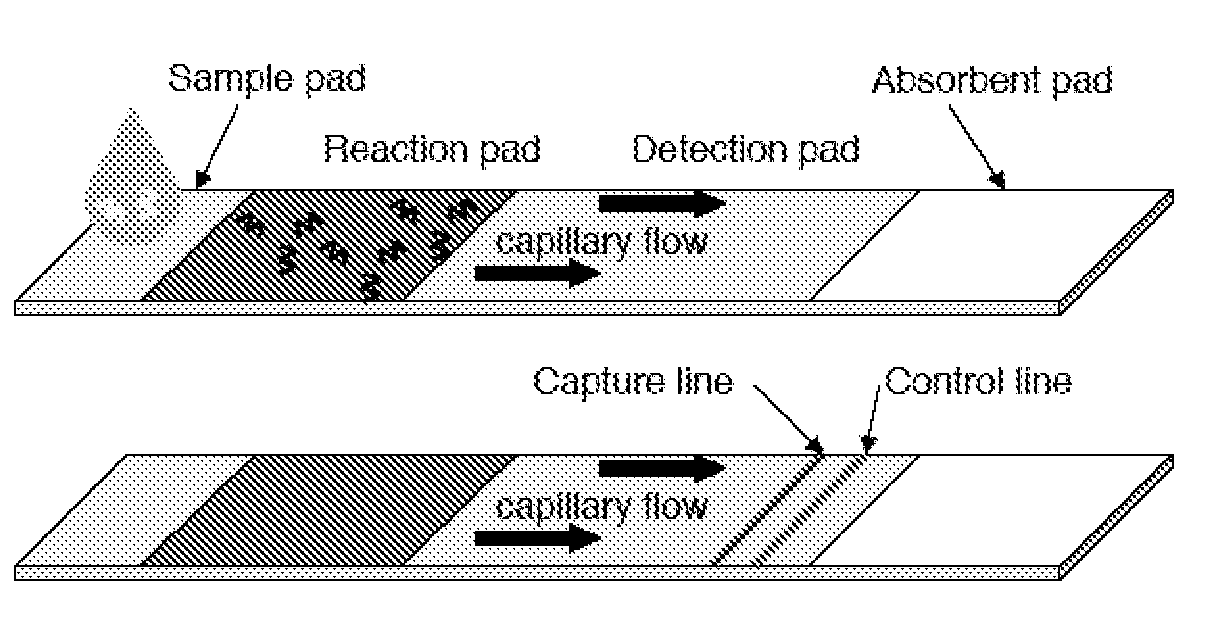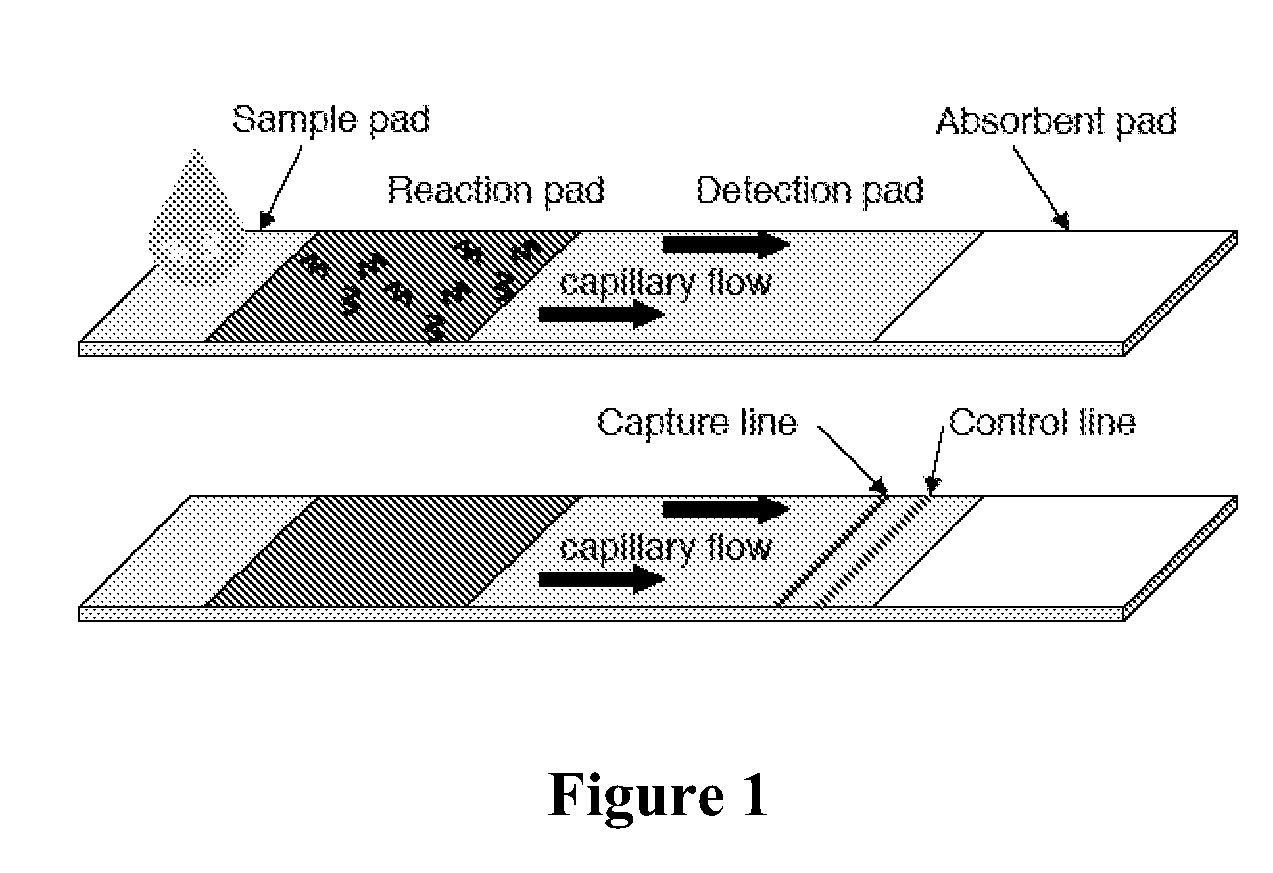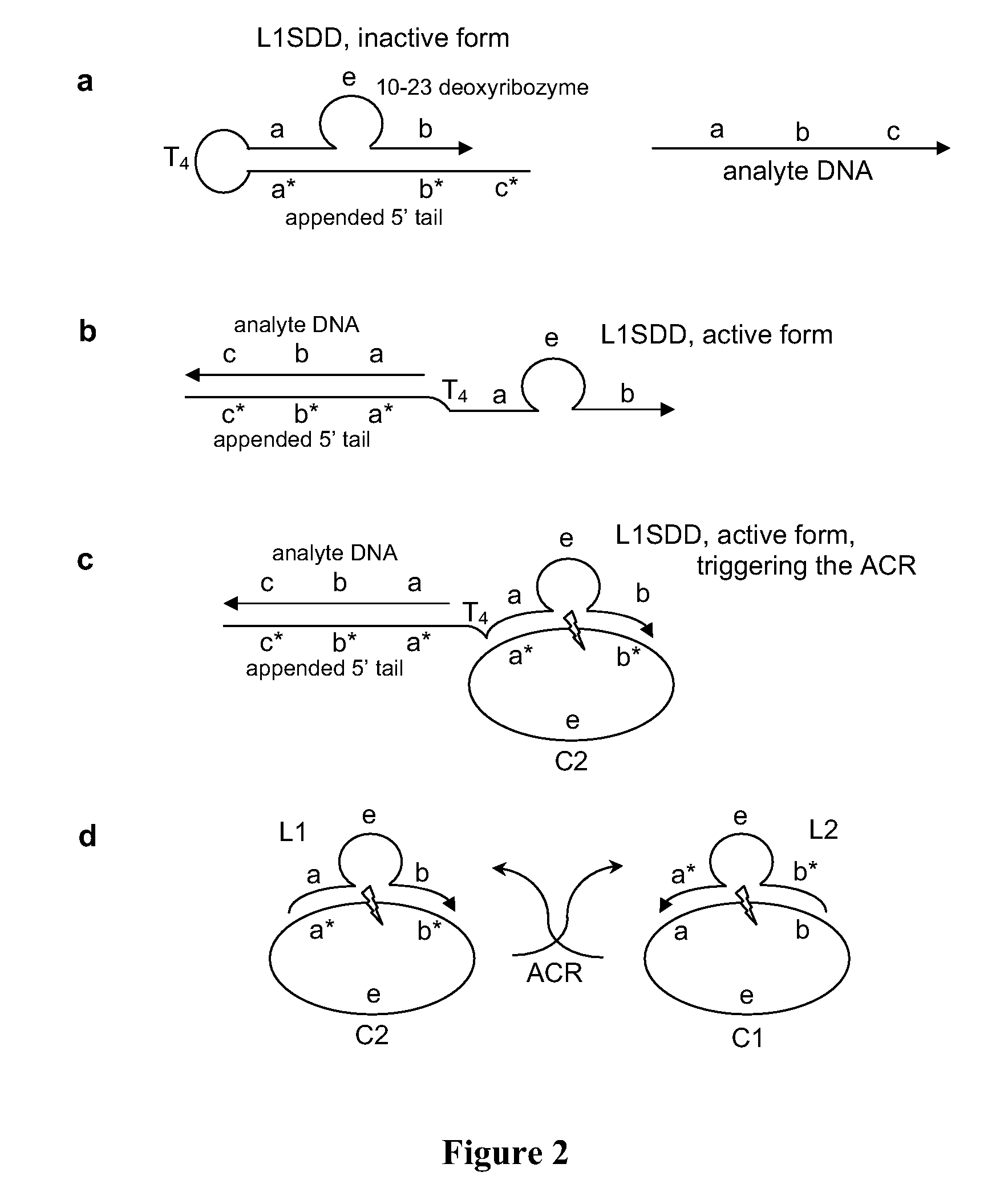Analyte detection using autocatalytic chain reactions
analyte detection and autocatalytic chain reaction technology, applied in the field of small amounts of analyte, can solve the problems of expensive methods, insensitive, and specialized equipment and skilled personnel to operate, and achieve the effects of reducing the number of analytical methods, and reducing the detection accuracy
- Summary
- Abstract
- Description
- Claims
- Application Information
AI Technical Summary
Benefits of technology
Problems solved by technology
Method used
Image
Examples
example 1
Cross Catalytic Cleavage ACR
[0051]In this example, the autocatalytic chain reaction (ACR) is an exponential cross-catalytic cleavage reaction catalyzed by the 10-23 deoxyribozyme as described in Levy, M., et al., PNAS (2003) 100:6416, incorporated herein by reference. The 10-23 deoxyribozyme is a highly efficient and sequence specific enzyme for cleaving RNA or ribonucleic acid phosphodiester linkages within DNA sequences. The 10-23 deoxyribozyme does not cleave DNA linkages. A circular form of this enzyme is inactive, but the linear form is catalytic.
[0052]The ACR employs a mixture of circularized, hence inactivated, 10-23 deoxyribozymes, C1 and C2, each containing a small RNA portion susceptible to cleavage. See FIG. 2. C2 can hybridize with, and can subsequently be cleaved by, a cleaved and linearized C1 (designated L1). Symmetrically, C1 can be cleaved by an active L2, which is a linearized C2. The products of the activated ACR, L1 and L2, thus accumulate exponentially.
[0053]In ...
example 1.01
[0055]In this incarnation, the NSD is a 10-23 deoxyribozyme which has been modified for strand displacement using a 5′ appended, 21 nucleotide tail. See FIG. 2a, where it is labeled as L1SDD (Loop 1 Strand Displacement Detector). L1SDD has substrate recognition sub-sequences, a and b, the enzyme sub-sequence e, and the 21 nucleotide tail tethered by a tetraloop, T4 (TTTT). The 21 nucleotide tail has a sequence that is complementary to the 10-23 deoxyribozyme substrate recognition sub-sequences (a*b*) plus an additional 5′ sequence, c*, that facilitates analyte hybridization. The analyte DNA has the sequence (from 5′ to 3′) a b c.
[0056]Absent the analyte, L1SDD has a hairpin structure that inactivates the deoxyribozyme. When contacted by the analyte, the tail and analyte hybridize, opening the hairpin to its open active configuration, see FIG. 2b. In the analyte-bound open form, L1SDD acts as a trigger initiating the ACR as described above, see FIG. 2c.
[0057]In FIGS. 2A-2d, arrowhea...
example 1.02
[0058]This incarnation is similar to Example 1.01, except the NSD is a circularized 10-23 deoxyribozyme as in construct C1 that has been hybridized to a texaphyrin-oligonucleotide conjugate. The texaphyrin-oligonucleotide conjugate can photo-induce sequence-specific cleavage of C1 when the appropriate photon energy is present. The photo-cleaved, open form of C1 acts, in a manner analogous to Example 1.01, as a trigger for ACR. This construct is therefore a sensitive detector for specific photon energies (in this case, low-energy radiation between 690-880 nm). This C1-texaphyrin-oligonucleotide complex NSD is referred to as L1hνD1 (Loop 1 Photon Detector 1).
[0059]Neither the electromagnetic radiation nor the texaphyrin-oligonucleotide conjugate alone will induce cleavage. Absent the photon analyte, the closed-circle configuration of L1hνD inactivates the deoxyribozyme and the ACR remains in its poised state. Photosensitizer-oligonucleotide conjugates having absorbencies in other ener...
PUM
| Property | Measurement | Unit |
|---|---|---|
| Structure | aaaaa | aaaaa |
| Resonance | aaaaa | aaaaa |
Abstract
Description
Claims
Application Information
 Login to View More
Login to View More - R&D
- Intellectual Property
- Life Sciences
- Materials
- Tech Scout
- Unparalleled Data Quality
- Higher Quality Content
- 60% Fewer Hallucinations
Browse by: Latest US Patents, China's latest patents, Technical Efficacy Thesaurus, Application Domain, Technology Topic, Popular Technical Reports.
© 2025 PatSnap. All rights reserved.Legal|Privacy policy|Modern Slavery Act Transparency Statement|Sitemap|About US| Contact US: help@patsnap.com



